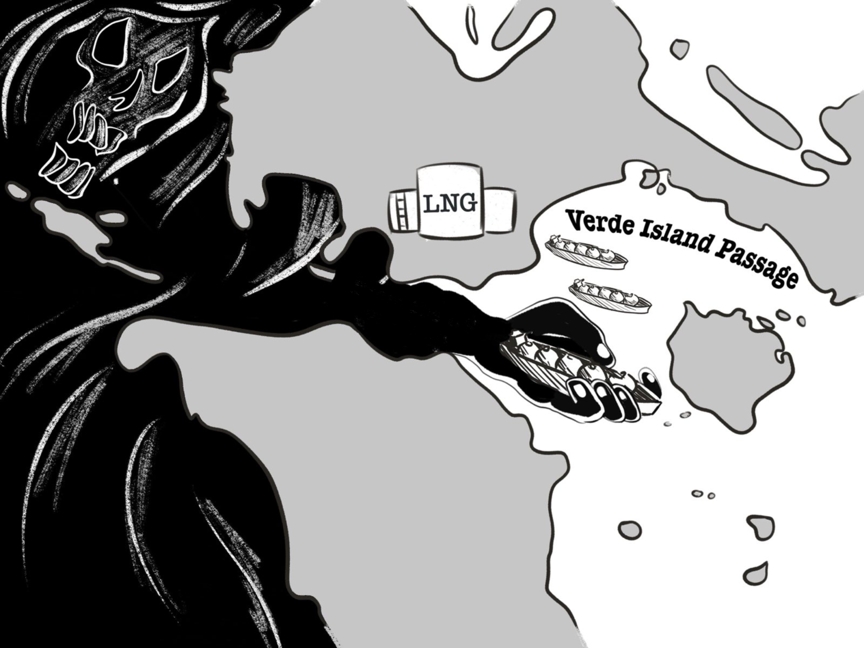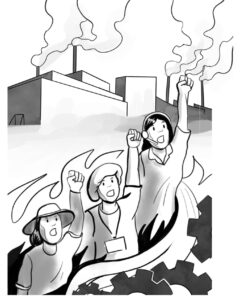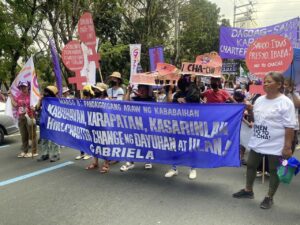Imported LNG, its facilities and plants, bring disaster to the environment and people


This March, three big bourgeoisie-compradors announced their “merger” for the operation of the Ilijan LNG terminal, the first “integrated LNG import facility” built by the Atlantic Gulf & Pacific Company (AG&P) along the coast of Barangay Ilijan, Batangas. City. Meralco PowerGen, Aboitiz Power and San Miguel Global Power (SMGP) converged to buy the said facility for $3.3 billion (₱184 billion).
The Ilijan LNG terminal covers nine hectares of land and up to 700 meters of the sea from the coast for a “floating storage” of LNG (liquefied natural gas). Apart from the port and storage, it will also serve as a facility for “regasification” (the process of transforming LNG from its liquid form to its original gas form). The facility will supply natural gas to the San Miguel Corporation (SMC)-owned giant power plant being constructed.
This facility and plant is among the 12 “terminals” and 35 new energy plants planned to be built to handle imported LNG and diesel. Seven of the terminals and eight of the new plants are slated to be built along the Batangas coast, in front of the Verde Island Passage (VIP). Others will be built in Leyte, Navotas City and Zamboanga. One of the LNG plants, planned to be built along the Tañon Strait in San Carlos, Negros Occidental, was temporarily blocked by protesting residents, churchgoers and environmental groups. Many of the LNG projects are championed by the SMC, in partnership with Japanese, American and British multinational institutions and banks.
Currently, there are six LNG plants operating in the country, and five of them lie along the Batangas coast.
Dumping US surplus LNG
The Philippines opened LNG imports from 2021 amid the reported imminent exhaustion of natural gas reserves in the Malampaya gas fields by 2027. The US used this opportunity to push the country to import LNG.
The US has been the world’s leading producer of LNG since 2011. It surpassed Russia, Australia and Qatar to become the number one exporter for the first time in December 2023. This is mainly due to the US seizure of Western Europe (Germany, France, UK, and others) markets for LNG that used to flow through Russian pipes. In addition to the US imposing sanctions against the purchase of LNG from Russia since the Ukraine war broke out, it blew up the Nordstream pipeline to prevent the smuggling of LNG. LNG terminals had to be built to store the LNG from the US that is being transported to Western Europe on large tankers.
As a direct result of the US proxy war with Ukraine, LNG prices have skyrocketed to $40 per million British thermal units (mmBtu) by 2022. However, US LNG overproduction has dragged the global market price down to $9.80 per mmBtu in 2023.
The US is now desperate to open new markets and monopolize old markets in Asia to dump its LNG surplus and keep demand and prices high. American companies such as ExxonMobil, Novatek and Chevron are most interested in importing LNG.
Although the price of LNG in the international market has dropped, it is only temporary and does not mean lower electricity bills in the Philippines. In 2023, imported LNG was $1-$3/mmBtu more expensive than domestic natural gas. The Institute for Energy Economics and Financial Analysis estimates that the price of energy produced from imported LNG is around ₱9 per kilowatt hour (kwh) to ₱16/kwh. This is higher than the average ₱7.38/kwh energy produced using the similarly imported coal and diesel in 2023, and ₱4.4/kwh using local solar power.
Despite definitely higher charges, the Department of Energy still required all distributors to source electricity from plants using imported LNG. According to the “energy map” of the Marcos regime, the Philippines will increase the use of imported LNG and “renewable” energies from 29% (of which 13% is LNG) to 35% by 2030 and 50% by 2050.
Threat to the VIP and livelihood of fisherfolks
LNG is marketed as a “transition fuel” being supposedly cleaner compared to coal and diesel. However, it still creates greenhouse gases (GHG) such as methane, carbon monoxide and carbon dioxide. In fact, studies show that the methane it produces is more harmful to the environment, because it is more potent in trapping heat in the atmosphere by 80-100 times longer than carbon dioxide.
Construction of the Ilijan LNG terminal started at the height of the pandemic (2021) and completed in 2023. It was built by AG&P, a company based in the United Arab Emirates, in partnership with Osaka Gas and the Japan Bank for International Cooperation. In February, American company Nebula Energy bought AG&P’s LNG-focused division.
In concurrence with the Ilijan LNG terminal, SMGP is now building the Batangas Combine Cycle Power Plant in Sta. Rita, Batangas. Although separate projects, the two facilities are connected and face the same side of the VIP.
Environmental group’s study show the two facilities, and others similar projects, threaten the VIP ecosystem that scientists consider the “richest marine habitat” in the world. During construction alone, sediment and sand already affect the seas beyond the scope of the facility. Construction disruptred the cycle and habitat of fish and other marine life not only in its immediate area, but throughout the entire VIP. This has resulted in a further decline in the quality of coral reefs and a decline in the catch of fisherfolks.
Aside from damaging the sea, AG&P also faces a case of illegal conversion of agricultural lands in the barangays of Ilijan and De La Paz. It also has cases of illegal cutting of coconut trees in the area. In fact, the Department of Agriculture issued a “cease and desist order” against the company last year due to its lack of a land conversion permit. AG&P and the Japanese banks ignored the order.
Hundreds of fisherfolks in Batangas have long been affected by the operations of the First Gen and SMC power plants. Before the new plants and facilities began construction, their last fish (tulingan and galunggong) catches have been halved since 2019. They were further constricted when fishing was banned from the shores near the construction.
In addition, residents fear the possible leakage of LNG into the ocean, more so because the VIP is vulnerable to strong and severe typhoons. VIP has not yet recovered, and may never recover, from the damage caused by the oil spill from the SMC-chartered vessel, the MT Princess Empress, last year.
Batangas air and water will become even more polluted once the coast is peppered with dirty energy plants. Marine life will also be more disturbed by increased traffic of imported LNG delivery ships.
Many coastal communities will lose their source of livelihood and even their homes. As many as two million Filipinos directly depend on the VIP for their livelihood.









